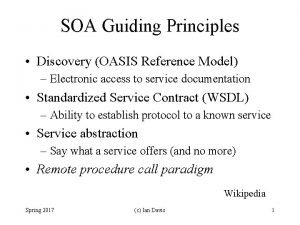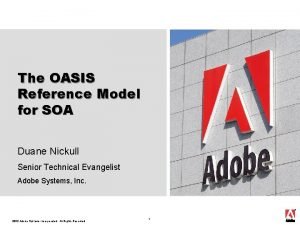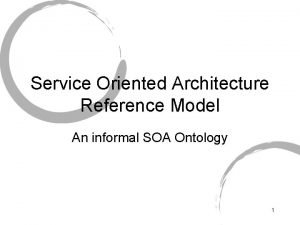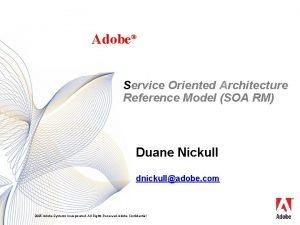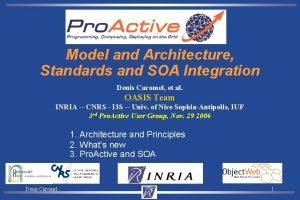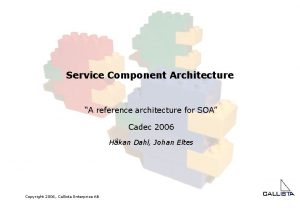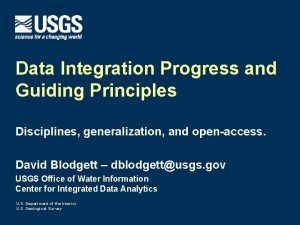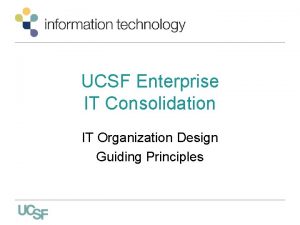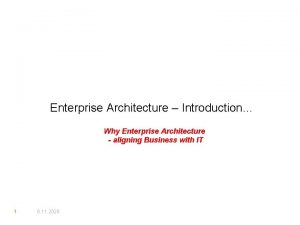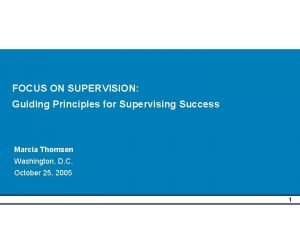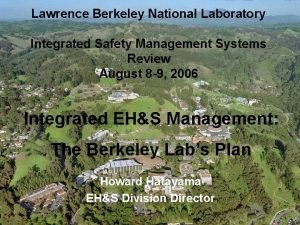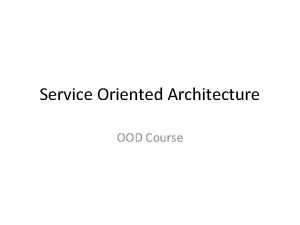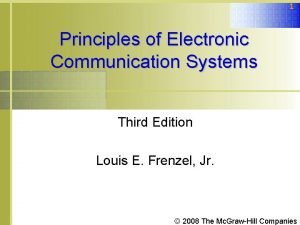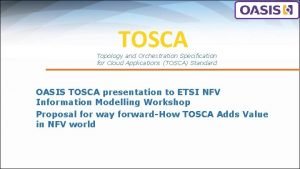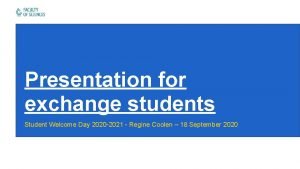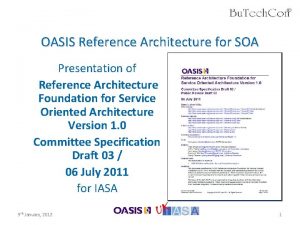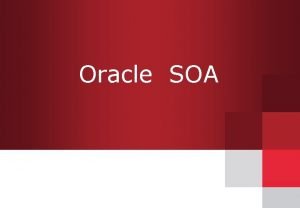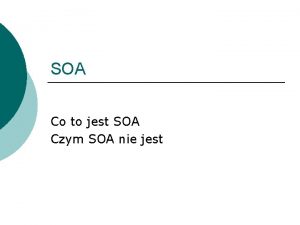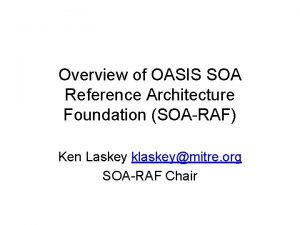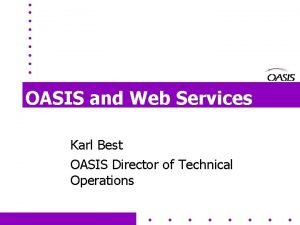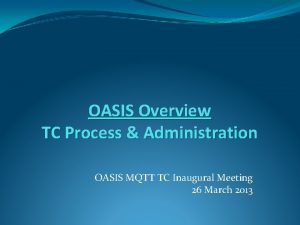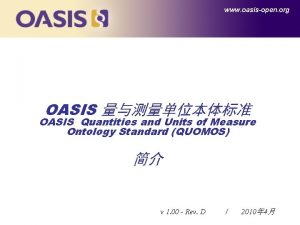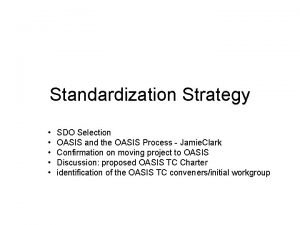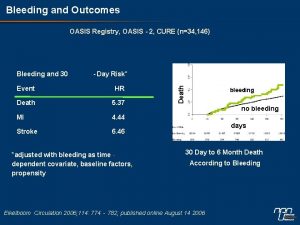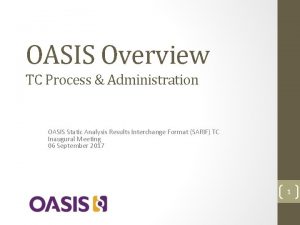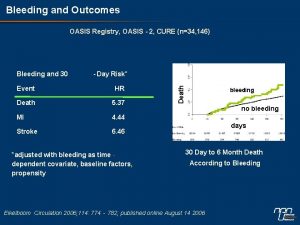SOA Guiding Principles Discovery OASIS Reference Model Electronic




































- Slides: 36

SOA Guiding Principles • Discovery (OASIS Reference Model) – Electronic access to service documentation • Standardized Service Contract (WSDL) – Ability to establish protocol to a known service • Service abstraction – Say what a service offers (and no more) • Remote procedure call paradigm Wikipedia Spring 2017 (c) Ian Davis 1

SOA Implementation Goals • Stateless (robust and scalable) • Service reusability – Generalize rather than specialize (usefulness) – Loose service coupling (minimize dependency) – Composability (simplify reusability) • Service autonomy – Ability to change / Ability to survive change Wikipedia Spring 2017 (c) Ian Davis 2

Web services • A common standard to support SOA – Focus on simplicity and interoperability • Offers – Find out about a service (WSDL) – Find an instance of that service (UDDI) – Ask a service to do something (SOAP) – Assisting standards (e/g. Security) (WS-*) • XML based, with HTTP transport layer – HTTP is firewall friendly - ergo dangerous • Basically implemented as automated emails Spring 2017 (c) Ian Davis 3

REST Versus SOA • REST – A simple client server interface (Text based) – What the server does is encoded in the message – Familiar well understood established standard – Transparency w. r. t. client requests – Must know URL of end point – Circumvents firewalls (requires only HTTP) – If you want it you create it • No security, reliability, etc. – Message paradigm Spring 2017 (c) Ian Davis 4

• SOA – More flexible – Network of interacting components (Procedural) – Access to rich set of WS-* standards and features – Reusable tool based architecture – Supports distribution/replication of components – Offers better security, reliability, interoperability – Complex evolving set of standards – Layered architecture paradigm Spring 2017 (c) Ian Davis 5

N-tier Architectures Spring 2017 (c) Ian Davis 6

Action Domain Responder Stateful Request Java. Script Browser Many scripts PHP SQL HTML • Typical web development style – https: //github. com/pmjones/adr Spring 2017 (c) Ian Davis 7

Multi tier Architecture Spring 2017 (c) Ian Davis 8

Three Tier (Display↔Process ↔State) • Display and User interaction – E. G. Client Browser • Thin (Just Display and front end interaction) • Thick (Lots of additional front end computation) • Processing – E. G. Back End Server • Business Logic • State or Model – E. G. Database Spring 2017 (c) Ian Davis 9

– Source: Wikipedia Spring 2017 (c) Ian Davis 10

Multi Tier • More than three tiers – Routing between Display and Process – Distributed Processing – Distributed Database Layer Spring 2017 (c) Ian Davis 11

Layered. v. Multi Tier • Layered architecture – Architecture based on logical division • Multi tier architecture – Leverages Client Server – Architecture based on physical division – Architecture more dependent on infrastructure • Assume client has browser • Assume server running apache, etc. Spring 2017 (c) Ian Davis 12

Multi-tier advantages • Code is located where most efficiently run • Scalability – Multiple clients can share one server – Multiple servers can share one data base • Multi-threading support – built in to Browsers, Apache and SQL • Leverages existing technology Spring 2017 (c) Ian Davis 13

Multi tier Disadvantages • Communication overhead • Hard to perform regression testing etc. • Hard to debug – No single debugger can watch everything – Hard to interpret logs • Dependent on remote resources – More points of possible failure Spring 2017 (c) Ian Davis 14

Data Centric Architecture Spring 2017 (c) Ian Davis 15

Blackboard/Repository Style • Suitable for applications in which the central issue is establishing, augmenting, and maintaining a complex central body of global information. • Typically the information must be manipulated in a variety of ways. Often long-term persistence is required. (c) Ian Davis 16 Spring 2017

Repository Style (Cont’d) • Components: – A central “global” data structure representing the correct (or known) state of the system. – A collection of independent components that operate on the central data structure. • Connectors: – Typically procedure calls or direct memory accesses. (c) Ian Davis 17 Spring 2017

Repository Style (Cont’d) (c) Ian Davis 18 Spring 2017

Blackboard Architecture • No deterministic solution to problem – Global state more as currently known than correct • Lots of experts can assist solve the problem • Have the experts independently collaborate – Like a team working on a blackboard – But typically without knowledge of each other • Any expert can add to current knowledge • Each experts improvement may help others Spring 2017 (c) Ian Davis 19

Mixture of experts • Example – One is good at predicting normal load behaviour • (But terrible for predicting when peak loads will occur) – One is good for predicting high load behaviour • (But terrible at predicting more normal loads) – Weight predictions based on past accuracy – Switch to which ever is currently best predictor An Empirical Investigation of An Adaptive Utilization Prediction Algorithm 23 rd Annual International Conference on Computer Science and Software Engineering CASCON 2013 Spring 2017 (c) Ian Davis 20

Repository Style • Consistency of global data – Policed, controlled through locking etc. • Database – SQL (Relational database) – OMDG (Object oriented database) • Database is viewed as a server – All requests performed by clients Spring 2017 (c) Ian Davis 21

Repository Style Interaction • ODBC / OLEDB / Ph. P connectors etc. • Triggers – Invoke PL/SQL • External clients can be notified of changes – Implicit invocation • SQL 3 promises to be computationally complete. Spring 2017 (c) Ian Davis 22

Repository Style Specializations • Data structure in memory – Real time – Persistent but limited memory – Ipod Nano • Data structure on disk – SQL – Ipod Classic • Atomic Transactions • Concurrent computations and data accesses. (c) Ian Davis 23 Spring 2017

Rule Based / Expert System • Repository is a collection of facts (rules) – New facts can be added and old facts deleted – Can ask questions about these facts • Inference engine infers answer from facts • Prolog – A. I. Programming language • Satisfiability solvers Spring 2017 (c) Ian Davis 24

Repository Style Examples • • • Information Systems Programming Environments Graphical Editors AI Knowledge Bases Ipod Web (HTML data model) – Architecture nodes and links between them (c) Ian Davis 25 Spring 2017

Repository Style Advantages • Efficient way to store data. • Sharing model is available as a schema • Centralized management: – backup – security – concurrency control • Ability to easily extend the data schema • Reliable (no need to test) (c) Ian Davis 26 Spring 2017

Repository Style Disadvantages • Must agree on a data model a priori. – Partially addressed through views • Difficult to distribute data. – Partially addressed through distributed DB. • Data evolution is expensive. – Because much may have to be changed • Scalability (read once write everywhere) – Somewhat addressed by distributed DB (c) Ian Davis 27 Spring 2017

DISTRIBUTED REPOSITORY Spring 2017 (c) Ian Davis 28

Scalable Data Architectures • Vertical Scaling – Buy Faster CPU / More memory / Larger Disks • Horizontal Scaling – Buy more cheap servers – Parallelism – Routing Spring 2017 (c) Ian Davis 29

Usage of Data • On-line Transaction Processing (OLTP) – Large volumes of INSERT/UPDATE/DELETE – Simple SELECT statements (direct recovery) – Goal: Storage/Retrieval: Transactions Per Second • On-line Analytical Processing (OLAP) – Warehoused data (Extract / Transform / Load) (ETL) – Very complex operations on the data – Goal: Knowledge: Response time per query Spring 2017 (c) Ian Davis 30

Spring 2017 (c) Ian Davis 31

Spring 2017 (c) Ian Davis 32

Star Schema https: //en. wikipedia. org/wiki/Star_schema Spring 2017 (c) Ian Davis 33

Snowflake Schema https: //en. wikipedia. org/wiki/Snowflake_schema Spring 2017 (c) Ian Davis 34

RDBMS SQL systems • • • Spring 2017 My. SQL (Free) Oracle DB 2 SQL Server Etc. (c) Ian Davis 35

www. youtube. com/watch? v=-N 9 i-YXo. QBE&list=PL-tg-8 BR 7 u 1 f 0 u. H-b 4 m 5 gr 144 a. P 0 ket. Ek cdn. oreillystatic. com/en/assets/1/event/100/Big%20 Data%20 Architectural%20 Patterns%20 Presentation. pdf Spring 2017 (c) Ian Davis � 36
 A desert herder who traveled from oasis to oasis
A desert herder who traveled from oasis to oasis Oasis reference model
Oasis reference model Soa reference model
Soa reference model Soa reference model
Soa reference model Soa reference model
Soa reference model Soa reference architecture
Soa reference architecture Soa roadmap
Soa roadmap Soa reference architecture
Soa reference architecture Sendai framework guiding principles
Sendai framework guiding principles Wmels
Wmels Systemic reforms of ncf 2005
Systemic reforms of ncf 2005 End goals of mtb-mle
End goals of mtb-mle Mcpons guiding principles
Mcpons guiding principles Evolution of eia
Evolution of eia Integration guiding principles
Integration guiding principles Org design guiding principles
Org design guiding principles Project portfolio management guiding principles
Project portfolio management guiding principles Enterprise architecture principles
Enterprise architecture principles Guiding principles for dual language education
Guiding principles for dual language education Na guiding principals
Na guiding principals Guiding principles of supervision
Guiding principles of supervision Principles of eia
Principles of eia Madrid guiding principles
Madrid guiding principles Isms guiding principles
Isms guiding principles Ood and soa principles
Ood and soa principles An electronic is the electronic exchange of money or scrip
An electronic is the electronic exchange of money or scrip Electronic field production
Electronic field production Reference node and non reference node
Reference node and non reference node Reference node and non reference node
Reference node and non reference node Principles of electronic communication systems 3rd edition
Principles of electronic communication systems 3rd edition Principle of electric circuit
Principle of electric circuit Principles of electronic communication systems 3rd edition
Principles of electronic communication systems 3rd edition Tosca orchestration
Tosca orchestration Regine coolen
Regine coolen Gatica lleva acento
Gatica lleva acento Current oasis 7
Current oasis 7 Oasis nextgen
Oasis nextgen

